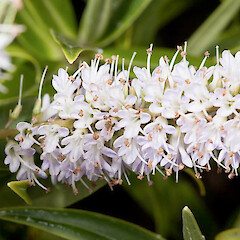Veronica stricta var. egmontiana
Synonyms
Hebe salicifolia var. egmontiana Cockayne nomen nudum, Hebe stricta var. egmontiana L.B.Moore
Family
Plantaginaceae
Flora category
Vascular – Native
Endemic taxon
Yes
Endemic genus
No
Endemic family
No
Structural class
Trees & Shrubs - Dicotyledons
NVS code
The National Vegetation Survey (NVS) Databank is a physical archive and electronic databank containing records of over 94,000 vegetation survey plots - including data from over 19,000 permanent plots. NVS maintains a standard set of species code abbreviations that correspond to standard scientific plant names from the Ngä Tipu o Aotearoa - New Zealand Plants database.
HEBEGM
Chromosome number
2n = 80
Current conservation status
The conservation status of all known New Zealand vascular plant taxa at the rank of species and below were reassessed in 2017 using the New Zealand Threat Classification System (NZTCS) – more information about this can be found on the NZTCS website. This report includes a statistical summary and brief notes on changes since 2012 and replaces all previous NZTCS lists for vascular plants.
Please note, threat classifications are often suggested by authors when publications fall between NZTCS assessment periods – an interim threat classification status has not been assessed by the NZTCS panel.
- Conservation status of New Zealand indigenous vascular plants, 2017 . 2018. Peter J. de Lange, Jeremy R. Rolfe, John W. Barkla, Shannel P. Courtney, Paul D. Champion, Leon R. Perrie, Sarah M. Beadel, Kerry A. Ford, Ilse Breitwieser, Ines Schönberger, Rowan Hindmarsh-Walls, Peter B. Heenan and Kate Ladley. Department of Conservation. Source: NZTCS and licensed by DOC for reuse under the Creative Commons Attribution 4.0 International licence.
2017 | At Risk – Naturally Uncommon | Qualifiers: RR
Previous conservation statuses
2012 | Not Threatened
2009 | Not Threatened
2004 | Not Threatened
Brief description
Bushy shrub bearing pairs of long narrow pointed thin leaves inhabiting Mt Taranaki. Leaves variable, to 106 mm long, widest at base and tapering towards narrow tip. Leaf bud with no gap at base. Flowers white or pinkish, spike to 16 cm long.
Distribution
Endemic. New Zealand: North Island (Mount Taranaki (Egmont National Park)).
Habitat
Common in open sites within montane forest and in subalpine scrub.
Wetland plant indicator status rating
Information derived from the revised national wetland plant list prepared to assist councils in delineating and monitoring wetlands (Clarkson et al., 2021 Manaaki Whenua – Landcare Research Contract Report LC3975 for Hawke’s Bay Regional Council). The national plant list categorises plants by the extent to which they are found in wetlands and not ‘drylands’. The indicator status ratings are OBL (obligate wetland), FACW (facultative wetland), FAC (facultative), FACU (facultative upland), and UPL (obligate upland). If you have suggestions for the Wetland Indicator Status Rating, please contact: [Enable JavaScript to view protected content]
FACU: Facultative Upland
Occasionally is a hydrophyte but usually occurs in uplands (non-wetlands).
Detailed description
Compact shrub or small tree 2–(4) m tall. Branchlets glabrescent. Stem internodes shorter than or equal to stem diameter. Leaf bud without sinus. Leaves spreading, 60–70–(100) mm, dark green, yellow-green or glaucous (not glossy), linear-lanceolate, fleshy, tapering to a narrow acute tip, leaf margin usually entire, or toothed. Inflorescence lateral, racemose, much longer than leaves, occasionally drooping, bracts and calyx-lobes ciliolate otherwise all other inflorescence structures glabrous. Flowers white, not obviously scented. Corolla tube 6 mm, exceeding calyx, narrow, cylindric, lobes rounded. Capsules < 5 mm long, glabrous, erect to spreading.
Similar taxa
Veronica stricta var. egmontiana and var. lata differ from other varieties by their compact branching habit, somewhat firmly fleshy leaves, which may be dull or glossy, shorter stem internodes and tetraploid chromosome number. Veronica stricta var. egmontiana differs from var. lata by the linear-lanceolate, dull green (not glossy) leaves, and generally larger growth form. There are other subtle floral differences which appear to align this variety with Veronica phormiiphila (also known as Hebe paludosa).
The name Veronica stricta var. egmontiana is here used in the sense of the original naming author, such that this variety is restricted to Mt Egmont. However some field botanists feel that those tetraploid plants found on the Central Volcanic Plateau and the greywacke ranges (Kaimanawa and Kaweka Ranges) named var. lata should be merged with var. egmontiana at species rank. This unpublished opinion has confused the literature as to where var. egmontiana actually occurs.
Flowering
(July)–August–(October) but flowering can also occur sporadically throughout the year
Fruiting
(September)–November–(January) but seed capsules may be found throughout the year
Propagation technique
Easy from fresh seed and semi hardwood cuttings.
Threats
No active threats are known. Veronica stricta var. egmontiana is assessed as ‘At Risk – Naturally Uncommon’ becuae its restricted distribution makes it susceptible to new advers effects, should they arise.
Etymology
veronica: Named after Saint Veronica, who gave Jesus her veil to wipe his brow as he carried the cross through Jerusalem, perhaps because the common name of this plant is ‘speedwell’. The name Veronica is often believed to derive from the Latin vera ‘truth’ and iconica ‘image’, but it is actually derived from the Macedonian name Berenice which means ‘bearer of victory’.
stricta: From the Latin strictus ‘upright, stiff’
egmontiana: Of Mount Egmont
Where To Buy
Not commonly cultivated. Occasional available from garden centres. An attractive plant, worthy of species rank.
Attribution
Fact Sheet Prepared by P.J. de Lange (1 February 2005). Description based on Allan (1961)—see also Bayly & Kellow (2006)
References and further reading
Allan HH. 1961. Flora of New Zealand, Volume I. Indigenous Tracheophyta: Psilopsida, Lycopsida, Filicopsida, Gymnospermae, Dicotyledones. Government Printer, Wellington, NZ. 1085 p.
Bayly MJ, Kellow AV. 2006. An illustrated guide to New Zealand Hebes. Te Papa Press, Wellington, NZ. 388 p.
NZPCN Fact Sheet citation
Please cite as: de Lange, P.J. (Year at time of access): Veronica stricta var. egmontiana Fact Sheet (content continuously updated). New Zealand Plant Conservation Network. https://www.nzpcn.org.nz/flora/species/veronica-stricta-var-egmontiana/ (Date website was queried)







